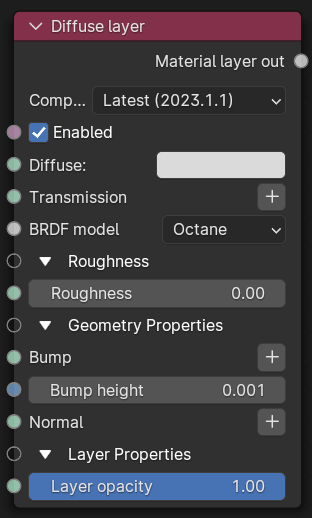Diffuse layer
The Diffuse layer creates dull, non-reflective Materials. See the Diffuse Material topic in this manual for more information.

Figure 1: Diffuse layer Node
Parameters
- Compatibility version - The Octane version that the behavior of this node should match.
- Enabled - Whether this layer is applied or skipped.
- Diffuse - The layer's diffuse color.
- Transmission - The layer's transmission color. This can be used for thin translucent objects.
- BRDF model - From Wikipedia: "The bidirectional reflectance distribution function (BRDF), is a function of four real variables that defines how light from a source is reflected off an opaque surface."
- Octane
- Lambertian
- Oren-Nayar
- Roughness - The Diffuse layer's roughness. High values simulate very rough surfaces like sandpaper or clay.
- Bump - Creates fine details on the material’s surface using a Procedural or Image texture. Often a Greyscale image texture connects to this parameter - light areas of the texture indicate protruding bumps, and dark areas indicate indentation. You can adjust the Bump map's strength by adjusting the Power or Gamma values on the Image texture node.
- Bump height - The height represented by a normalized value of 1.0 in the bump texture. 0 disables bump mapping, negative values will invert the bump map.
- Normal - Distorts layer normals using an RGB image.
- Layer Opacity - Controls the layer opacity with a Greyscale texture.